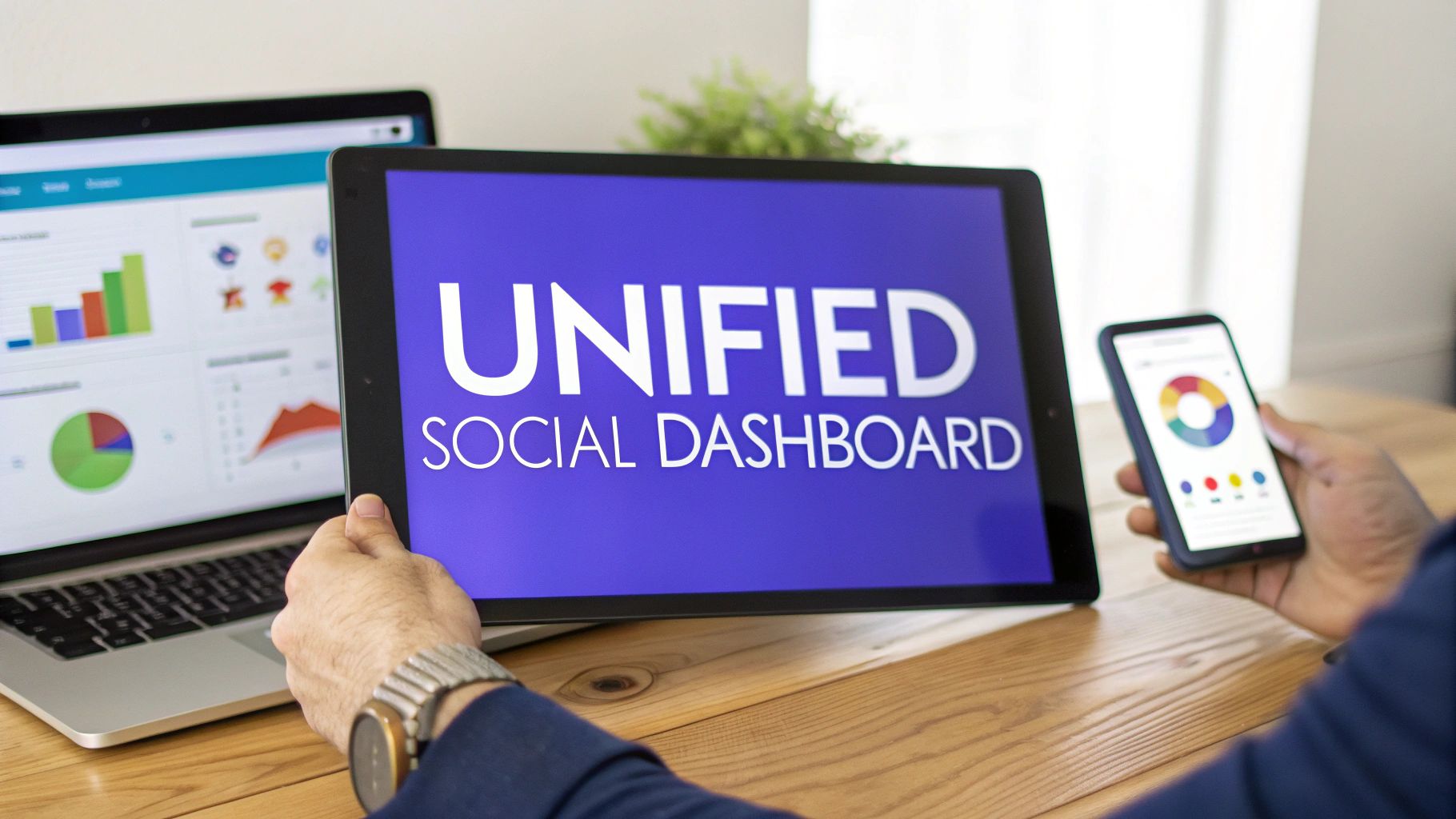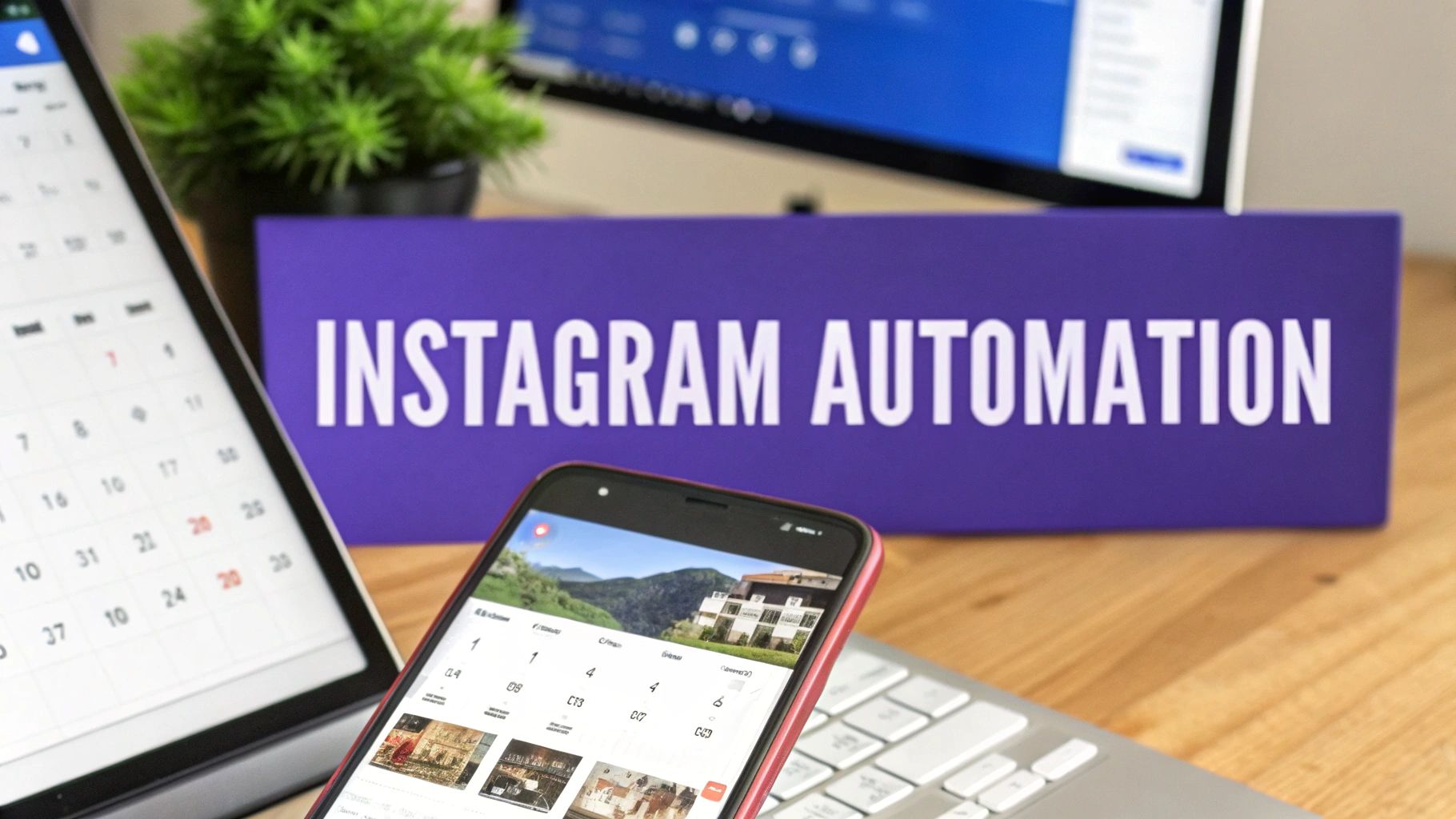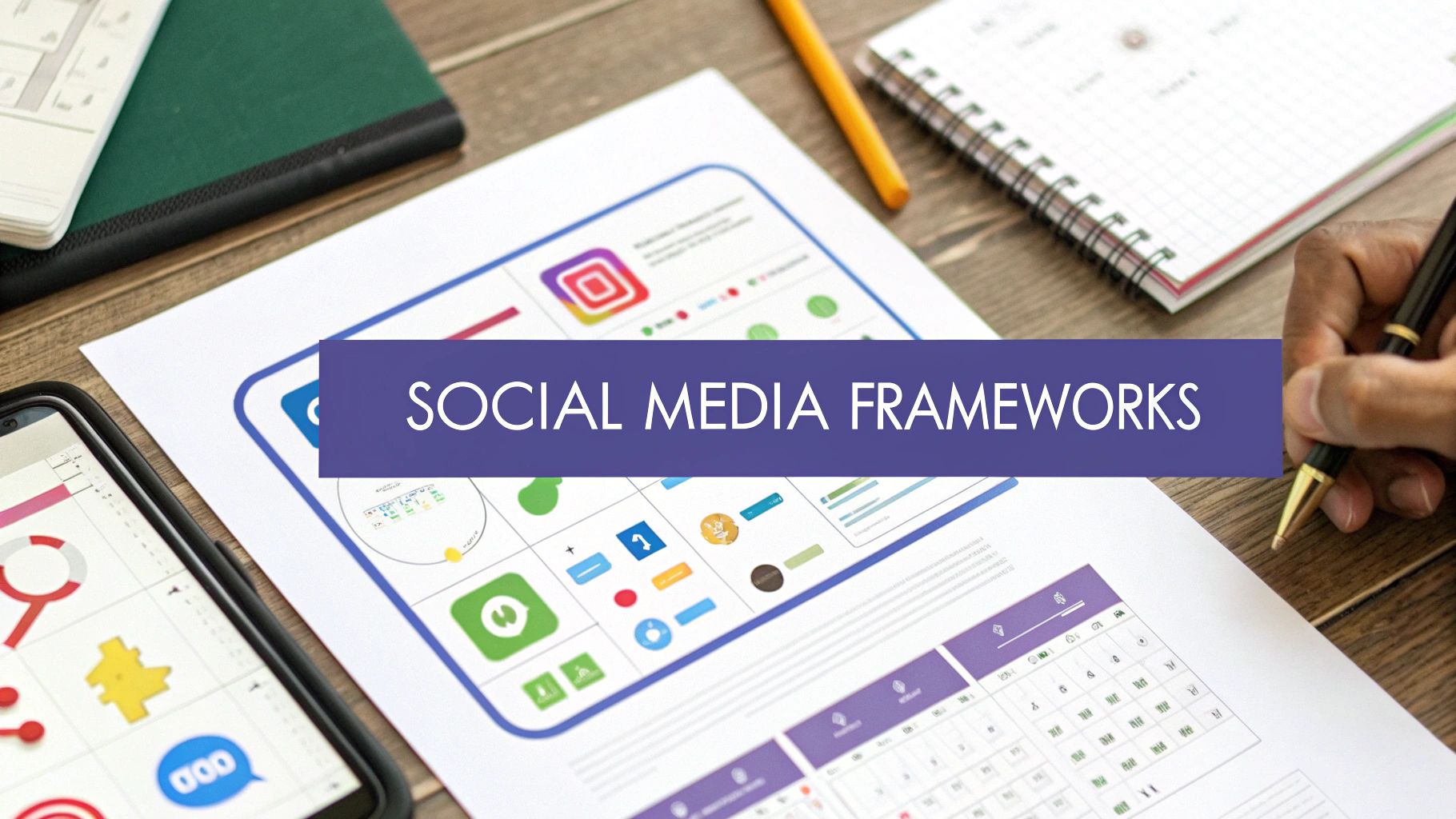If you're managing more than one social media account, you know the chaos. It feels like you're constantly jumping between apps, putting out fires, and trying to keep everything straight. The only way to win this game is to move from that frantic, manual posting to a single, strategic workflow.
This means pulling all your profiles into one central dashboard, building a smart content strategy you can scale, and letting automation handle the heavy lifting of scheduling and analysis. It's not just about saving time—it's about keeping your brand consistent and, frankly, saving your own sanity.
Why You Need a Better System for Your Social Media
Juggling a dozen social profiles isn't just for big marketing agencies anymore. It's the new reality for creators, small businesses, and anyone trying to build a brand online. The pressure is on to maintain a unique voice for each platform, engage with different audiences, and somehow keep up with trends that change overnight. Without a solid plan, you're just reacting, guessing what might work, and heading straight for burnout.
The real headache isn't just the sheer number of posts. It's the complexity. Each platform—LinkedIn, Instagram, TikTok—is its own universe with its own rules, algorithms, and audience expectations. A professional deep-dive that kills it on LinkedIn will get zero traction on a visual-first platform like Instagram. Trying to manage all of this manually is a guaranteed path to wasted effort and missed opportunities.
Just How Big Is the Challenge?
The digital noise is getting louder every single day. The numbers are staggering: in 2025, there are around 5.42 billion people on social media globally. On average, each person is active on 6.83 different social networks every month. You can learn more about these global social media trends to really grasp the scale.
This fragmented audience is both your biggest opportunity and your biggest management nightmare.
The key is to stop thinking about each social profile as a separate chore. Instead, see your entire social media presence as one connected ecosystem that you can manage from a single command center.
This guide is your blueprint for building that system. I'll walk you through a clear, actionable workflow to consolidate, schedule, monitor, and truly optimize all your profiles.
We're going to build your new workflow around a few essential pillars. This table gives you a quick overview of the strategy we'll be covering.
Core Pillars of Multi-Account Management
| Pillar | Objective | Key Benefit |
|---|---|---|
| Unified Dashboard | Consolidate all social profiles into one central hub. | Gain complete visibility and control, eliminating the need to switch between apps. |
| Scalable Content Strategy | Develop a master content plan adaptable for different platforms. | Create high-quality content efficiently without starting from scratch for each network. |
| Smart Automation | Use AI and scheduling to handle repetitive posting tasks. | Free up your time to focus on creative strategy and genuine audience engagement. |
| Performance Tracking | Monitor key metrics to understand what's actually working. | Move beyond vanity metrics to make data-driven decisions that fuel real growth. |
By mastering these four areas, you'll fundamentally change how you approach social media, turning it from a source of stress into a powerful engine for growth. Let's get started.
Building Your Unified Social Media Dashboard
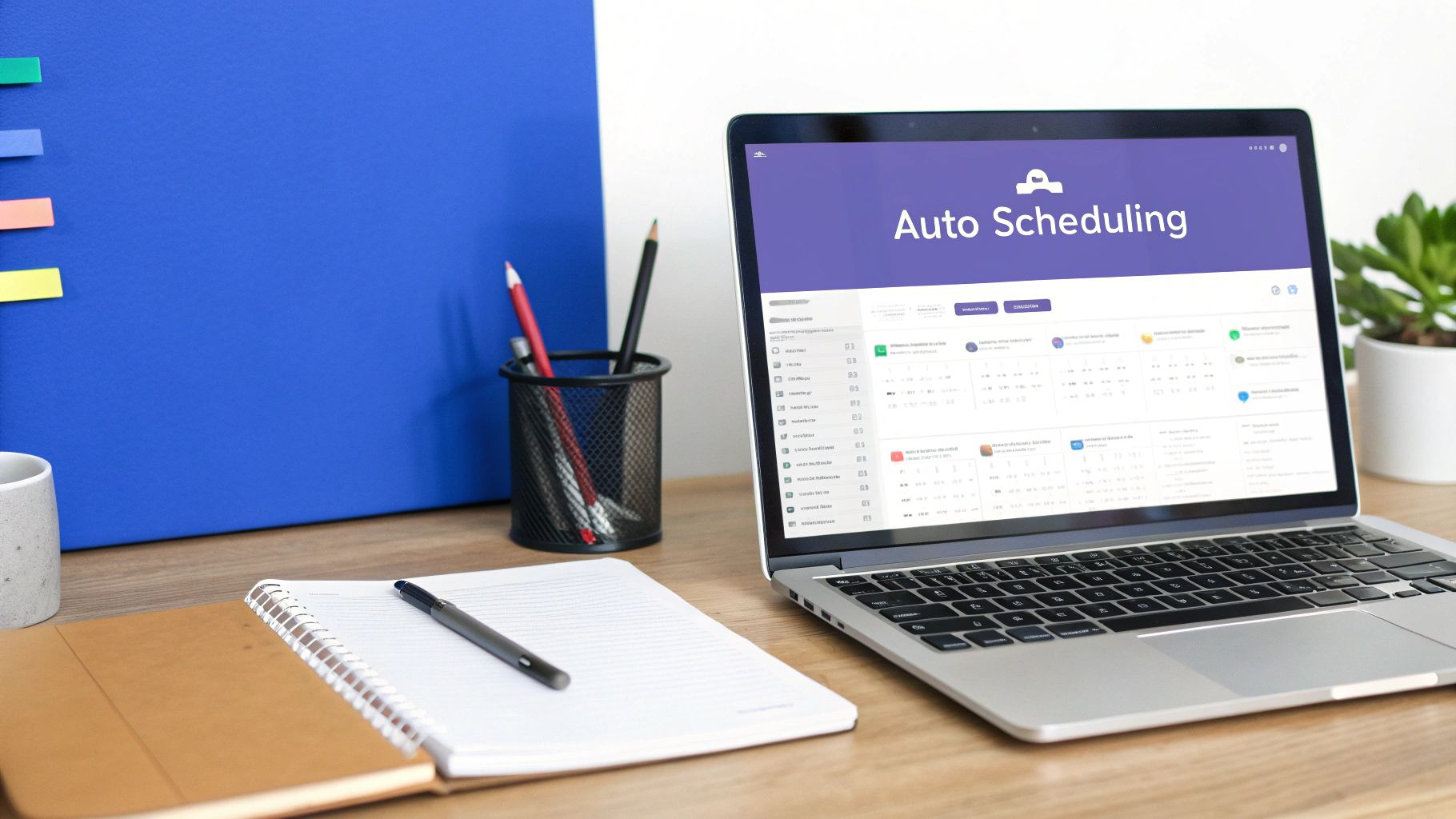
Take a look at that screenshot from Sprout Social. That's the dream, right? A single, clean view of your entire social media universe. This isn't just about making things look tidy; it’s about swapping a chaotic, multi-tab nightmare for a streamlined command center.
From one place, you can see every scheduled post, check all incoming messages, and track your performance without constantly logging in and out of different platforms. Getting this level of organization is the first real step toward managing multiple social accounts effectively.
Choosing Your Command Center
Picking the right tool is about more than just comparing feature lists. The best platform for you is the one that fits your specific workflow and needs.
Think of it like choosing a car. A solo creator might just need a nimble scooter to get around town (like Buffer), while a large agency needs a full-sized bus with room for the whole team and all their clients (like Sprout Social or Hootsuite).
For the Solo Creator or Small Business: Keep it simple. You need an intuitive interface for quick scheduling and basic analytics. A platform like Buffer is perfect here, offering a clean user experience without burying you in enterprise-level features you'll never touch.
For the Growing Agency: Now, collaboration is everything. You'll need features for client approvals, assigning tasks to team members, and creating separate workspaces for each brand. This is where tools like Hootsuite and Sprout Social really shine, since they're built for robust team management and detailed reporting.
If you're a creator looking to bring all your digital tools under one roof, you might want to explore creator platforms like Makerbox that offer features to help centralize your entire operation. The goal is to find a single source of truth.
What Really Matters in a Management Tool
When I first started managing accounts for multiple clients, I got completely lost comparing features. It took me a while, but I eventually realized only a handful of functions actually save you hours every single week.
A unified inbox is non-negotiable. Missing a critical customer service question or a hot sales lead because it was buried in one of ten different inboxes is a costly mistake you can easily avoid. Centralizing all your DMs and comments is your safety net.
Beyond the inbox, pay close attention to the quality of the scheduling tools. A great scheduler does more than just post at a specific time. It should let you create content queues, customize posts for each network, and visually plan your calendar. You can learn more about effective https://postsyncer.com/social-media-scheduling in our detailed guide on the topic.
Key Features and Their Use Cases
To make a smart choice, you have to match features to your daily tasks. Here’s a breakdown of what to look for based on real-world needs.
| Feature | Best For This Use Case | Why It's Important |
|---|---|---|
| Unified Smart Inbox | Teams handling customer service or high-volume engagement. | Prevents missed messages and allows you to assign conversations to the right team member, ensuring prompt replies. |
| Collaborative Workflows | Agencies and marketing teams that need client or manager approval. | Creates a clear approval chain, reducing errors and ensuring all content is brand-aligned before it goes live. |
| Advanced Analytics | Data-driven marketers who need to prove ROI to stakeholders. | Moves beyond vanity metrics (likes) to track meaningful data like clicks, conversions, and engagement rates per post. |
Ultimately, picking your dashboard is about building the foundation for your entire social media operation. It’s the single most important step in taking back control and strategically managing your accounts—instead of letting them manage you.
Developing a Scalable Content Strategy

Let's be real: just spraying the same exact post across every social network is a recipe for getting tuned out. I see it all the time. A truly scalable content strategy isn't about one-size-fits-all posting; it's about creating a core content engine that you can smartly adapt for each platform’s unique audience and vibe.
This is how you avoid the creative exhaustion that comes from starting with a blank slate every single day. You end up producing higher quality content, more consistently, which is absolutely critical when you're juggling multiple social profiles. To really make this work, you have to get your overarching social media content strategy locked in.
Establish Your Core Content Pillars
Before you even think about writing a single post, you need to define your content pillars. These are the 3-5 big-picture topics your brand will own and talk about over and over again.
For instance, a fitness coach I worked with landed on "Workout Tutorials," "Nutrition Myths," and "Client Success Stories." Simple, right? But incredibly effective.
These pillars are your strategic guardrails. When it's time to brainstorm, you're not just plucking random ideas from thin air. You're looking for ideas that fit neatly under one of your pillars. This keeps your brand message tight and makes planning so much easier.
- Pillar 1: Educational "How-To" Content
- Pillar 2: Behind-the-Scenes Peeks at Your Company Culture
- Pillar 3: Industry News and Your Take on It
- Pillar 4: User-Generated Content and Testimonials
The Power of Content Batching
If you take one productivity tip from this guide, make it this one: content batching. Instead of the daily scramble, you block out dedicated time to create a week's or even a month's worth of content all at once.
Picture this: you spend a Monday afternoon writing all the copy for your LinkedIn posts and related blog articles for the whole month. The next day, you film all your short-form video clips for Reels and TikTok. It's like an assembly line for your content. You minimize context switching, get into a deep creative flow, and honestly, the quality of your work goes way up.
Think of it like meal prepping. You wouldn't cook a brand new meal from scratch three times a day, seven days a week. You do the prep work once to make the rest of the week a breeze. Content batching is that same exact logic, but for your social media.
Tailor Content for Each Platform
Okay, you've got your pillars and your batched content. Now for the magic: adaptation. This is where you customize your core message for each network. A single customer testimonial, for example, can be a goldmine.
Here’s how you could spin one great piece of feedback:
- LinkedIn: A text-only post quoting the client. The focus here is professional—all about the business results and ROI they saw.
- Instagram: A sharp-looking graphic with the quote overlaid. You could share it as a Story or in a carousel post, maybe with a few behind-the-scenes photos from the project.
- Facebook: A longer, more story-driven post. Tell the client's whole journey and ask questions to get your community talking in the comments. As of 2025, Facebook is still the giant with 3.065 billion monthly users, making it perfect for this kind of community-focused content. You can discover more insights about social media demographics on SproutSocial.com.
- TikTok: A snappy video. Maybe the client themselves says a few words (if you're lucky!), or you create a dynamic text-on-screen video that summarizes their awesome results.
By doing this, you're speaking the native language of each platform. Your engagement will shoot up, but your workload won't triple. You create one core asset, then customize how it's delivered. That’s the secret to managing multiple social accounts without going crazy.
How to Automate Your Workflow with AI and Scheduling
Simply pushing content out isn't the goal. The real win is reclaiming your time to focus on what actually moves the needle—strategy and genuine engagement. This is where a smart, semi-automated system becomes your most valuable asset, especially when juggling multiple social media accounts. We're talking about moving beyond basic scheduling to build a workflow that handles the repetitive, time-sucking tasks for you.
True automation isn't just about queuing up a post for 2 PM on Tuesday. It's about using data to find the best possible times for each specific account and its unique audience. I've found that modern platforms are brilliant at this; they analyze your past performance to suggest optimal slots, making sure your content gets in front of the most eyes possible.
Using AI as Your Creative Assistant
Let’s get one thing straight: AI isn’t here to replace your creativity. Think of it as a powerful assistant that can smash through creative blocks and take care of the grunt work. When you're managing several profiles, the demand for fresh content is relentless. This is where I've seen AI truly shine.
I often start by using it for brainstorming. Just feed an AI tool one of your core content pillars and ask for a list of blog titles, short-form video ideas, or common customer questions. This simple step can turn a daunting blank page into a list of actionable ideas in seconds.
- Drafting Initial Copy: Use AI to generate a first draft of a post. It's rarely perfect out of the box, but it gives you a solid foundation to edit and inject your brand’s unique voice.
- Creating Visuals: Tools can now generate images or video concepts from a simple text prompt. This is a game-changer for creating eye-catching graphics for Instagram or Facebook without needing a designer on standby.
- Suggesting Responses: Some platforms even use AI to suggest replies to common comments or DMs, helping you keep engagement high without manually typing out every single response.
To give you a clearer picture, here’s a quick breakdown of how AI can slot into your daily tasks.
AI Tools for Social Media Management Tasks
| Task | Recommended AI Tool Type | Primary Benefit |
|---|---|---|
| Content Ideation | Generative AI Chatbots (e.g., ChatGPT, Gemini) | Overcomes writer's block by generating topics, angles, and questions. |
| Copywriting | AI Writing Assistants (e.g., Jasper, Copy.ai) | Creates initial drafts for posts, ads, and captions, saving hours of writing time. |
| Visual Creation | AI Image Generators (e.g., Midjourney, DALL-E 3) | Produces custom visuals and graphics from text prompts, reducing design costs. |
| Scheduling | Smart Schedulers with AI (e.g., PostSyncer) | Analyzes past performance to recommend optimal posting times for each platform. |
| Community Management | AI-Powered Reply Tools (within some platforms) | Suggests responses to common inquiries, speeding up engagement. |
As you can see, AI isn't a single tool but a category of assistants that can handle very specific, time-consuming parts of the job.
Building a Smart Scheduling System
Your scheduling system should work for you, not the other way around. My advice? Stop scheduling posts one by one. Instead, set up content queues for each of your key pillars or themes. You can fill these queues during your content batching sessions, and your scheduling tool will automatically pull from them to fill your calendar.
The goal is to create a reliable, "set it and forget it" content flow. By combining evergreen content queues with timely, trending posts, you ensure your profiles are always active and relevant, even on your busiest days.
This approach is incredibly powerful when you’re managing accounts for different brands or clients. You can create separate, customized workflows for each one without getting wires crossed. To really nail your scheduling process, it's worth reviewing a dedicated guide on using a Facebook scheduler effectively, as many of the core principles apply across all social networks.
The process flow below visualizes how you can use data to continuously refine your posting strategy. It’s a loop I live by.
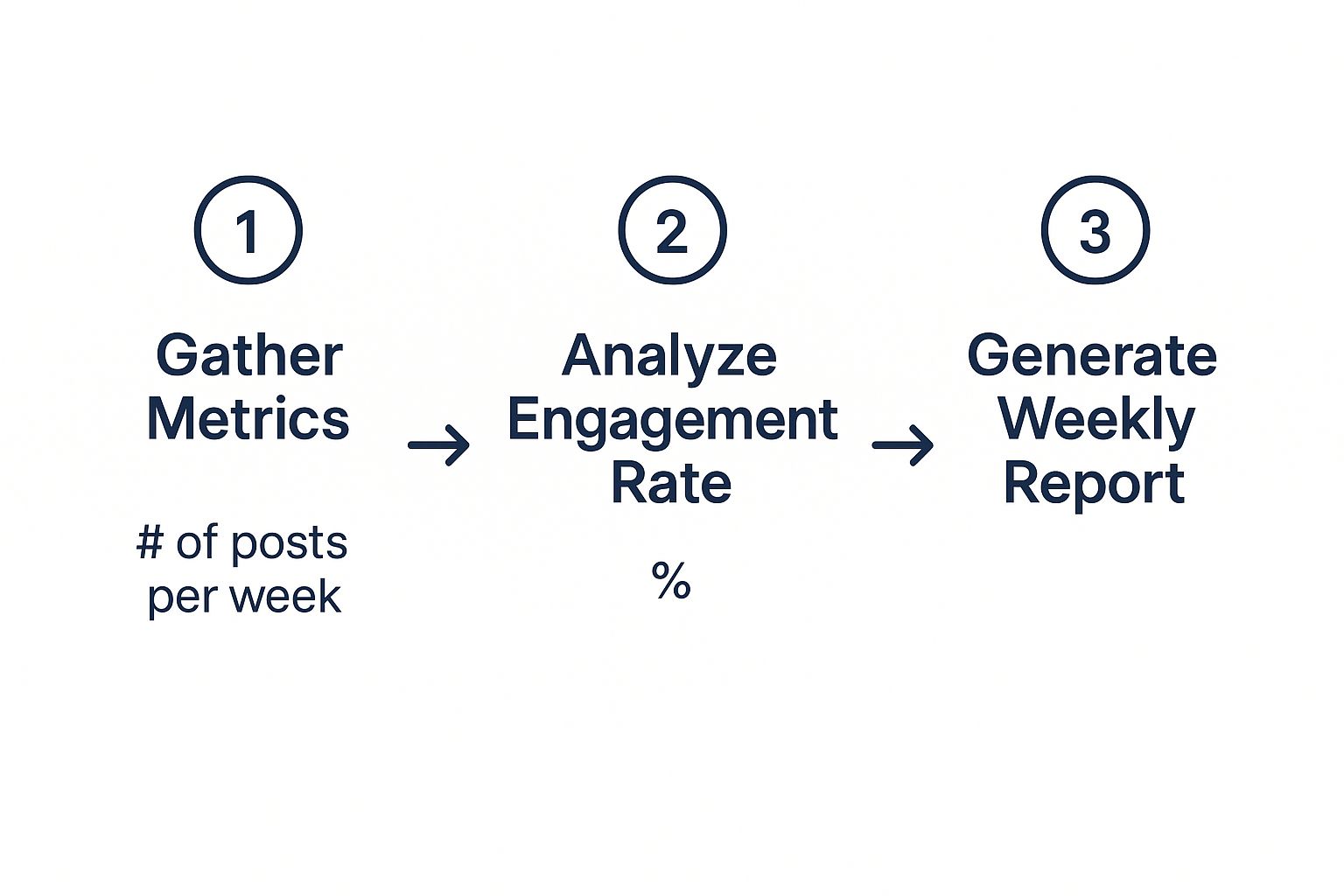
This simple loop—gathering metrics, analyzing what works, and reporting on it—is the engine of a successful automated strategy. And if you want to boost productivity beyond just social media, you can also explore some useful AI Chrome extensions.
By embracing smart scheduling and AI assistance, you transform your workflow from reactive to proactive. You’ll free up that invaluable time for the high-impact strategic work that only a human can do.
Tracking Performance and Optimizing for Growth

Pushing content live across all your channels is just the starting line. If you aren't paying close attention to what happens after you hit "publish," you're really just guessing your way toward growth. The real magic in managing multiple social media accounts happens when you start monitoring performance, truly listening to your audience, and constantly tweaking your strategy based on cold, hard data.
Think of it this way: this process turns your social media from a one-way content machine into a powerful feedback loop. You quickly learn what resonates, what falls flat, and, most importantly, where to invest your precious time and budget for the best possible return.
Setting Up Your Social Listening Streams
Social listening is your secret weapon—an early-warning system that goes way beyond just tracking your @mentions and comments. From a single dashboard, you need to set up streams that monitor keywords tied to your brand, your products, your industry, and even your top competitors.
I once worked with a local coffee shop that did this perfectly. They set up streams for their brand name, sure, but they also listened for phrases like "best espresso near me" and the names of two rival cafes down the street. It only took a week for them to spot a conversation where customers were complaining about a competitor's weak coffee. This gave them the perfect, non-salesy opening to jump in with a friendly offer.
The most valuable insights often come from conversations where your brand isn't even tagged. By listening for relevant keywords, you can uncover customer pain points, identify potential leads, and manage your reputation proactively.
Creating Reports That Actually Matter
Let’s be honest: vanity metrics feel good, but they don't pay the bills. A massive follower count or a flood of likes is nice, but a truly practical performance report focuses on metrics that connect directly to your actual business goals.
Your objective is to dig deeper than the surface-level numbers to understand the why behind your performance. This is where you can find a wealth of information in our complete guide to social media automation tools, which can make gathering this data almost effortless.
Here are the core metrics I insist on including in my weekly reports:
- Engagement Rate: This is your pulse check, calculated as (Likes + Comments + Shares) / Followers. It tells you what slice of your audience is actually interacting with your content.
- Click-Through Rate (CTR): This shows how many people who saw your post cared enough to click the link. It’s a fantastic indicator of how compelling your copy and call-to-action are.
- Conversion Rate: If your goal is driving sales or sign-ups, this is the bottom line. It tracks how many of those clicks turned into the desired action, proving your ROI.
- Audience Growth Rate: It's not just about getting more followers, but the speed at which you're gaining relevant ones. This ensures your reach is expanding consistently, not stagnating.
Turning Insights into Actionable Growth
Data is completely useless if you don't act on it. Your final, and most crucial, step is using these insights to make smarter decisions. If you discover that short-form video tutorials on Instagram are driving 10x the engagement of your static image posts, the path forward is crystal clear: make more video.
This data-driven approach is essential when the fight for attention is so intense. In 2025, social media ad spending is projected to hit an incredible $276.7 billion worldwide. On top of that, 93% of marketers are planning to increase the time they spend on social marketing. You can discover more insights about social media statistics on SproutSocial.com.
By regularly analyzing what works and what doesn't, you stop wasting time and money on tactics that are going nowhere. Instead, you can reinvest those resources into the content and platforms that deliver real, measurable growth. This continuous cycle of tracking, analyzing, and optimizing is what separates the social media managers who struggle from the ones who succeed.
Common Questions About Managing Multiple Accounts
Even with the best tools in your corner, jumping into managing multiple social media accounts will stir up some practical questions. It’s totally normal. As you get into the rhythm of your new workflow, you'll inevitably run into a few common hurdles.
Let's tackle these head-on so you can move forward with confidence.
One of the biggest anxieties I hear about is handling negative feedback. When a critical comment pops up, does that mean you need to do damage control everywhere? The short answer: absolutely not.
Think of each platform as its own community. You should definitely address the feedback publicly right where it was posted. After that? Offer to take the conversation private—into DMs or email—to find a resolution. This approach contains the issue and shows everyone else that you're responsive without blasting negativity across all your profiles.
Another question that comes up all the time is about content. How much should be unique versus just crossposted? My go-to is the 80/20 principle. Roughly 80% of your content can be adapted from a core idea you've developed. The other 20%? That should be truly native to the platform. I'm talking about a spontaneous TikTok trend or a quick, interactive Instagram Story poll. This gives you the perfect mix of efficiency and genuine, platform-specific engagement.
Should I Use the Same Hashtags Everywhere?
This is a classic trap, and it's easy to fall into. Copying and pasting a block of 30 Instagram hashtags into a LinkedIn or X (formerly Twitter) post just looks sloppy. More importantly, it doesn’t work.
Every platform has its own unspoken rules for hashtags.
- Instagram: Go for a mix of broad and niche hashtags. You can use up to 30 to get your content in front of new eyes.
- LinkedIn & X: Keep it clean and professional. Stick to 1-3 super-relevant hashtags to categorize your content and join specific conversations.
- TikTok: The magic formula here is a blend of trending sounds or effects with hashtags specific to your video's content. This is your best shot at landing on the For You Page.
Taking a minute to customize your hashtags for each post is a small detail that makes a huge difference. It signals that you actually get the platform's culture, which can seriously boost your performance. It's a non-negotiable part of a smart multi-account strategy.
Think of your content as a core message and the platform as the language you use to deliver it. You wouldn't speak the same way in a boardroom as you would with friends. Tailor your delivery—including tone, format, and hashtags—to fit the room.
At the end of the day, great social media management isn't about being everywhere at once. It’s about being present and intentional wherever you show up. By using a central dashboard to keep an eye on things and having a smart content plan, you'll be able to handle these challenges with a clear, strategic approach.
Ready to stop juggling and start strategizing? PostSyncer provides a single dashboard to consolidate all your profiles, automate scheduling with AI, and track performance with meaningful analytics. Start your free 7-day trial of PostSyncer today and build a workflow that drives real growth.
